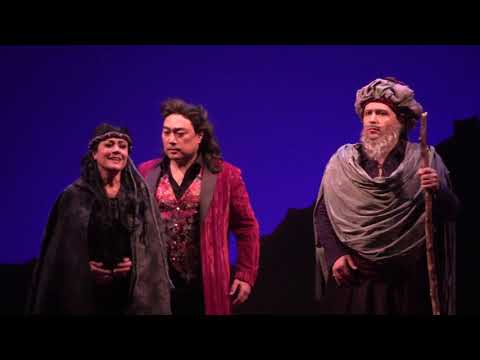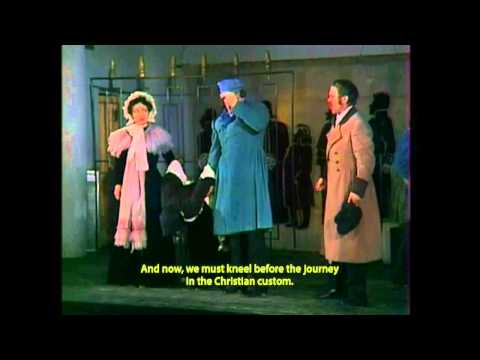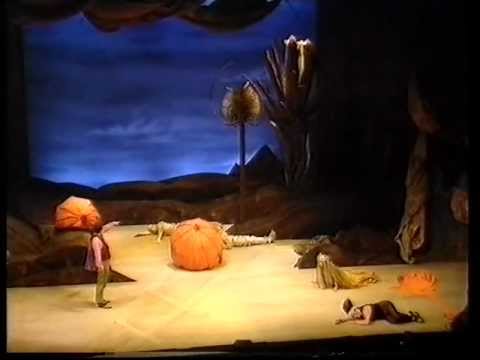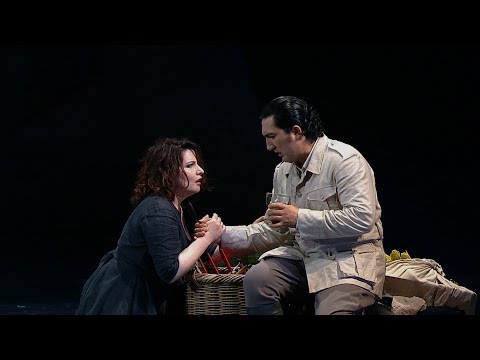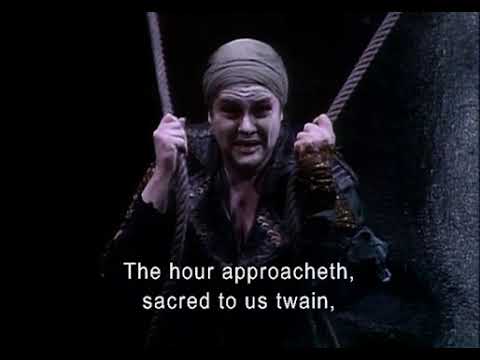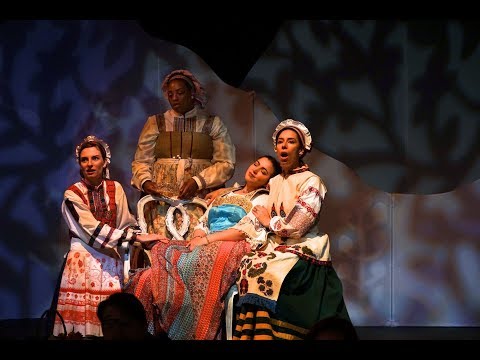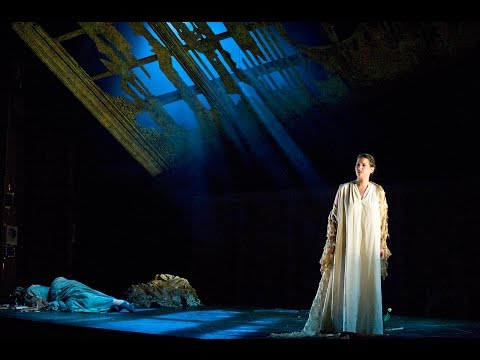Well, that describes even some of the famous and mainstream operas. But another set exists that takes things a bit farther than you might expect. From the classics to the obscure, these are 10 of the most bizarre operas.
10 Turandot
Set in Peking, Turandot—from composer Giacomo Puccini and librettists Giuseppi Adami and Renato Simoni—is something like a twisted horror story that turns into a sweet fairytale. If there is a message, it seems to be that love conquers all—even sociopathic narcissism. Turandot is a man-hating princess who has found a clever but ruthless way to avoid matrimony. When she has a suitor, he is required to answer three riddles correctly. If he fails, the suitor loses more than Turandot’s hand in marriage. He loses his life as the princess has him executed. Turandot’s new admirer, a stranger in the area named Calàf, risks his life by volunteering to be her suitor. However, he is up to the challenge, answering all three riddles. This leaves Turandot very upset that she will have to accept him as her husband instead of her next victim. In an effort to gain her love, Calàf generously offers Turandot one more chance to get rid of him, saying that if she can find out what his name is by dawn, he’ll let her kill him after all. So a massive effort is put forth to learn his name, even trying to torture it out of a slave girl who’s in love with Calàf, but she ends up killing herself instead. When Turandot tries to confront him that night, Calàf unexpectedly kisses her, evoking deep emotion from her. Believing he can now trust her, he shares his identity. The next day Turandot tells the emperor that she knows the man’s name, and “It is Love.”[1]
9 The Nose
The plotline might sound like something out of a vintage Jim Carrey comedy; however, The Nose is based on a satirical short story by Nikolai Gogol. It is actually a very prominent opera that was composed in the late 1920s by Dmitri Shostakovich, who wrote the libretto with Georgy Ionin, Alexander Preis, and Yevgeny Zamyatin. It is the story of an ambitious civil servant, Kovalyov, who discovers one morning that his nose is missing after visiting the barber the previous day. He goes in search of it only to find the missing appendage has grown to the size of a human being, developed a mind and will of its own, and outranks him in the civil service. After the police beat the nose down to its normal size and return it to Kovalyov, he is unable to have it reattached. He blames the mother of a woman he had refused to marry, suspecting she has put a spell on him, but her reply to his letter makes it clear that she is not responsible. The nose does eventually appear on his face again when Kovalyov least expects it, and the barber believed to have severed it in the first place is let out of jail.[2]
8 The Love for Three Oranges
Another satiric farce from a 20th-century Russian composer is The Love for Three Oranges (1921) by Sergei Prokofiev, who co-wrote the libretto with Vera Janacopoulos. The title is actually a pretty good description of the plot. Based on Vsevolod Meyerhold’s adaptation of the play by Carlo Gozzi, this opera is a romantic dramedy of sorts. It’s about a young prince who is cured of his melancholy by a witch who causes him to fall in love with three oranges, which he is compelled to search far and wide to find. He finally encounters the three huge oranges, each with a princess inside. When the first two oranges are peeled, the princesses who spring forth immediately die. The third time’s a charm, as orange #3, containing the most beautiful princess, survives, and they live happily ever after. This is a strange sort of fairytale, but it is a relief to find out the prince isn’t literally in love with the orange but rather with the girl inside.[3]
7 Medea
There are many operas involving violently dysfunctional families, but Luigi Cherubini’s Medea (1797) with a libretto by Francois-Benoît Hoffman is probably the most shocking. The conclusion of the story, in which Medea murders her own children, is so disturbing that we forget how strange the rest of the opera is. Based on Greek mythology and inspired by a Euripides play, it focuses on the insanely vengeful sorceress Medea. Watch this video on YouTube After Medea falls in love with Jason of the Argonauts, she helps him steal the Golden Fleece from her father, the king of Colchis. She later gives birth to his two sons, but Jason turns fickle and decides to marry someone else—Glauce, whose father Creon is King of Corinth. Medea is also losing the children, as he is taking their young sons with him. We know that Medea is deranged when she kills and dismembers her brother, scattering his body parts so her father will be too busy searching for the pieces of his son’s corpse to go after her. It’s no wonder Glauce is afraid of this psycho ex. Despite her prayers and King Creon’s efforts to protect Glauce, Medea eventually gets her revenge by implementing an evil plan. Medea uses her children to deliver what turns out to be poisonous wedding gifts to Glauce, including a lethal robe that melts her skin. Medea continues to punish Jason by doing the unimaginable: killing their two sons. This trail of gruesome murders ends with Medea committing suicide by setting herself on fire.[4]
6 Pagliacci
It may not be unusual for comedians to have a dark side. However, the combination of humor and tragedy in one individual has never been so startlingly illustrated as the character of Canio in Ruggero Leoncavallo’s hauntingly iconic opera Pagliacci. Canio, who manages a theatrical touring company, brings laughter to the crowds in his role as a clown on stage. But when he learns that his wife Nedda, the company’s leading lady, is planning to leave him for the handsome, young Silvio, he becomes insanely jealous. While there are fewer murders in this opera than some, Pagliacci is shocking in its own way. When Canio stabs Nedda, it is during a performance on stage while he is dressed as a clown. He goes on to kill Silvio when the man realizes what’s up and tries to save Nedda. The audience believes it’s all just part of the show until Canio announces, “The comedy is over.”[5]
5 Marnie
Based on the Winston Graham novel, which was made into the memorable 1964 Alfred Hitchcock film, the operatic adaptation of Marnie delivers more than enough sensationalistic plot twists. Whether or not this is a good thing depends on your tolerance for perpetual high drama. Composed by Nico Muhly with a libretto by Nicholas Wright, this 2017 opera focuses on a beautiful embezzler. She was psychologically damaged from a shocking childhood trauma which causes her to flee from any opportunity of a romantic relationship until she is blackmailed into marriage and tries to commit suicide. Marnie offers thrills and chills throughout, as well as psychoanalysis, which can be dramatic in its own way but unusual for the operatic stage.[6]
4 Die Frau ohne Schatten
We see many half-human characters in opera, but in Die Frau ohne Schatten (The Woman without a Shadow), the empress is a human-spirit hybrid desperate to become all human. The opera was composed by Richard Strauss with the libretto by Hugo von Hofmannsthal. The clock is ticking because if the empress does not accomplish this task in three days, her husband will be turned to stone, and she will be forced back to the spirit realm. One of the strangest parts of this story is a recollection by the emperor of how he first met his wife. He explains that she was a gazelle whom he was hunting. When he stabbed her with a spear, she turned into a woman. Unfortunately, his marriage to the gazelle woman has not produced any children. To make things even stranger, she has no shadow. The empress’s nurse tries to purchase the shadow of an ordinary woman by offering the poor housewife a glamorous life with a new man, and she initially agrees. The human emotions of compassion for the woman’s husband and the pain of seeing her own husband turned to stone allow the empress to finally cast her shadow, releasing the emperor from the stone.[7]
3 Elektra
Set in the aftermath of the Trojan War, Elektra, composed by Richard Stauss with a libretto by Hugo Von Hofmannstahl, was first performed in 1909. As some have speculated, this may be the bloodiest opera ever. Elektra is a princess driven mad after the murder of her father, King Agamemnon, by her ax-wielding mother, Klytaemnesta. The mother’s action was provoked by Agamemnon’s decision to sacrifice their daughter Iphigenia. At the beginning of this one-act opera, Elektra is already plotting to avenge her father’s murder by killing Klytaemnesta. However, she plans to have her brother do the dirty work. When he arrives at the palace after a long absence to find Elektra out of her mind, he obliges by killing Klytaemnesta and her lover. Elektra is so happy with the outcome that she literally dances until she drops.[8]
2 Iolanta
Composed by Peter Tchaikovsky and Béla Bartók with a libretto from the legendary composer’s brother Modest Tchaikovsky in collaboration with Béla Balázs, the 1891 opera Iolanta is a peculiar tale about a blind girl. Her father, King René, goes to great lengths to hide from his daughter that she is missing one of the five senses. Sheltered by her surroundings and caretakers, Iolanta is kept unaware that there is such a thing as sight and believes the only function of the eyes is to produce tears. This illusion is dispelled when a visitor to her home, Vaudémont, who is instantly attracted to Iolanta, realizes she is blind because she does not know the difference between a red rose and a white rose. He spills the beans about her disability, which infuriates her father, in part because he doesn’t want Iolanta’s betrothed to find out she is blind before they are married. A physician who may be able to cure Iolanta’s blindness insists the treatment will not work unless she really wants to see. To motivate her desire for sight, King René threatens to put Vaudémont to death if Iolanta remains blind. Luckily for everyone, especially Vaudémont, who’s allowed to live and marry Iolanta, the treatment proves successful, and she regains her vision.[9]
1 Ottone
The history of the Holy Roman Empire meets musical farce in George Frideric Handel’s popular 1723 opera Ottone with the libretto by Nicola Haym. An adaptation of Antonio Letti’s 1719 opera Teofane, this tangled plot is a fictionalized version of events related to the alliance-based wedding of future Roman Emperor Otto II and the Byzantine princess Theophanu. It’s ironic that so much of the story is invented since the real-life events following the wedding contain enough drama for a great opera. Teofane (Theophanu) arrives in Rome to meet and marry her betrothed Ottone (Otto II), who is delayed in battle. An imposter, Adelberto, shows up at the behest of his scheming mother, pretending to be Ottone so he can trick Princess Teofane into marrying him and try to take over the empire. When the real Ottone arrives, he has Adelberto jailed. Adelberto’s fiancée, Matilda, whips up some monsters and thunderbolts when Ottone refuses her plea for clemency. Adelberto escapes and teams up with a pirate to kidnap Teofane. Fortunately, the pirate turns out to be her long-lost brother. Teofane and Ottone wind up together and discover that even though it is an arranged marriage, they really like each other, which is one of the few parts of the story that’s actually true.[10]
